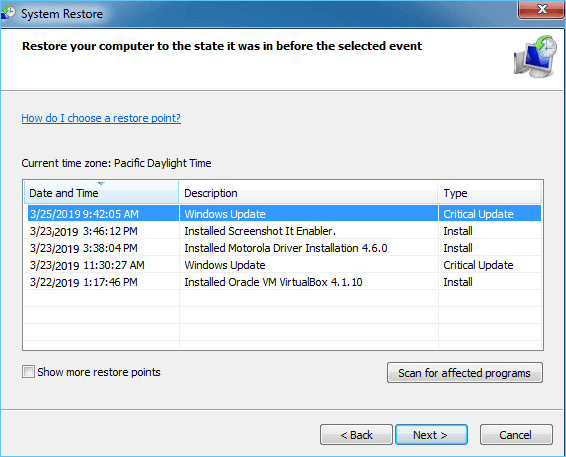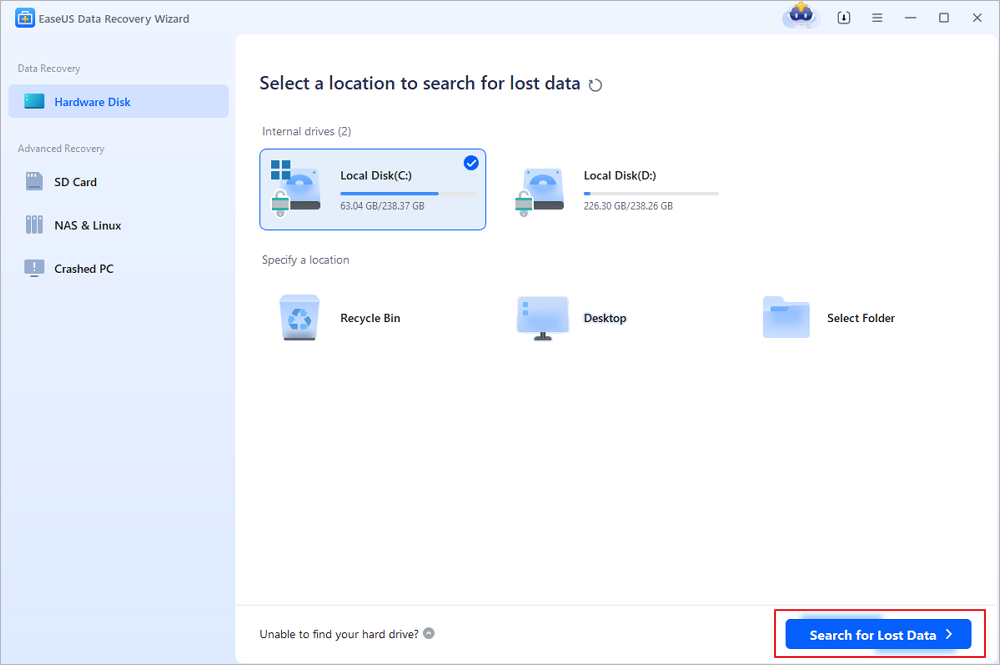"I'm thinking to perform a system restore, but I'm afraid of doing so because I know nothing about it. If I restore my computer from a restore point, will my files be deleted? I have many good videos downloaded from YouTube."
"How about my files or programs if I started a sytsem image recovery from a USB drive? Will my files be affected? What should I do to make sure that files stay safe?"
System Restore and System Image Recovery are both Microsoft Windows tools designed to protect and repair computer if it experiences boot issues. System Restore takes a "snapshot" of some system files and the Windows registry and saves them as Restore Points. While System Image Recovery plays the same role, only to note that it requires a system image before it can take effect. When an install failure or data corruption occurs, both system recovery options can return a system to working condition without you having to reinstall the operating system.
Will System Restore Delete My Files?
Based on the description of what a system restore works for in Microsoft Windows, it's clear that you can bring your computer to a healthy state by doing so. Some Windows users even think that it's the best way to recover permanently deleted files without using the software.
System Restore indeed provides you with a second chance to access some missing documents, videos, pictures, and folders that were included in the restore point. However, you should notice that system restore is never the best way for lost file recovery.
- Notice:
- Always bear in mind that a system restore will affect your system files, programs, drivers and registry settings. That's 100% true.
- Never take System Restore as a normal way to help you restore deleted or lost files on Windows PC.
When you're planning to make a system restore, take time and think for a while about what this behavior helps and ruins!
Here is a universal method that you can follow to check which programs, drivers and files will be affected by running System Restore on your PC:
Step 1. Press "Windows + R" keys in Windows 10/8/7 to bring up the Run box.
Step 2. Type rstrui.exe in the empty box and hit Enter. This will open System Restore.
Step 3. Select "Choose a different restore point" and click "Next".
Step 4. Click "Scan for affected programs".

It will then scan for programs and then list the programs and drivers which will be affected or not affected. Here is a form that lists the affected and not affected programs and files by running System Restore:
| Affected Programs and Files | Not Affected Programs and Files |
|---|---|
|
|
Will System Image Recovery Delete My Files?
Being slightly different than System Restore, a System Image Recovery is to restore a computer from a system image you created on a disk. A system image includes everything on your system C drive, including OS, programs and all personal files. When you perform a recovery by selecting a system image, it will overwrite data on the destination drive. So, yes, if you run system image recovery on your PC, it will delete all your files and then replace all of the files that were that when the image file was created.
Two Suggestions
As you can see that System Restore indeed will affect some programs and files on Windows PC. And it's indeed not an ideal way for simple file recovery. To protect your personal data and prevent files being deleted by system restore, here are two suggestions for you to take.
# 1. Restore Lost Data with Reliable Data Recovery Software (Instead of System Restore)
If you accidentally delete a file or the file is not recoverable from the recycle bin, take a third-party data recovery software for help. Unlike system restore, reliable file recovery software will only bring the lost files back without causing further damage to your currently existing data.
EaseUS hard drive recovery software - Data Recovery Wizard allows you to recover data from deletion, formatting or virus infection instead of doing a system restore.
Caution: Don't save the recovered files on the partition or drive where you lost your data before making sure the device is secure to save data again.
# 2. Create a Full System and File Backup
If you've already decided to restore your Windows OS to a previous version, an essential step that you must take is to create a new backup of valuable files and Windows OS in advance. That's the safest way to protect you from losing more data.
EaseUS Windows backup software will allow you to backup a whole disk or partition or simply individual files in 3 simple steps:
Step 1. Select a specific hard disk or location.
Choose the drive or partition where you deleted files. You can also select a specific location to scan, e.g. Recycle Bin, Desktop, or a folder. Then, click the "Search for Lost Data" button to start finding files.
Step 2. Start a quick or advanced scan for lost data.
When the scan is complete, you can see the detailed scan results, and you can filter the files or search them in the search box, which is the fastest way to find the target file.
Step 3. Preview and recover the files you need.
You can determine whether the scanned file is the one you want. Then, click the "Recover" button to save the recovered files to local storage or Cloud drive.

Was This Page Helpful?
Daisy is the Senior editor of the writing team for EaseUS. She has been working at EaseUS for over ten years, starting as a technical writer and moving on to being a team leader of the content group. As a professional author for over ten years, she writes a lot to help people overcome their tech troubles.
Jean is recognized as one of the most professional writers in EaseUS. She has kept improving her writing skills over the past 10 years and helped millions of her readers solve their tech problems on PC, Mac, and iOS devices.
Related Articles
-
macOS Sonoma Runs Slow After Update | 8 Ways to Fix
![author icon]() Brithny/Oct 25, 2024
Brithny/Oct 25, 2024 -
Black Myth: Wukong Save File Location & Config File Location
![author icon]() Jerry/Nov 25, 2024
Jerry/Nov 25, 2024 -
How to Create macOS Ventura Bootable USB Installer [macOS Ventura Tips]
![author icon]() Dany/Oct 25, 2024
Dany/Oct 25, 2024 -
[NEW] Fix USB Accessories Disabled on macOS 13 Ventura Effectively in Seven Ways
![author icon]() Dany/Oct 25, 2024
Dany/Oct 25, 2024